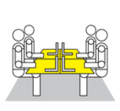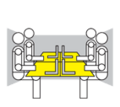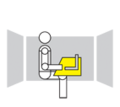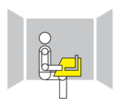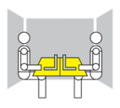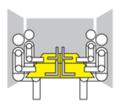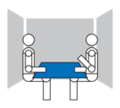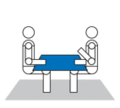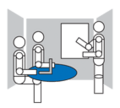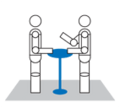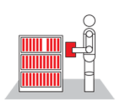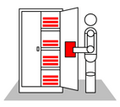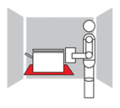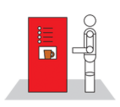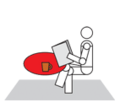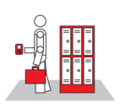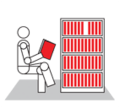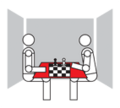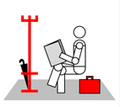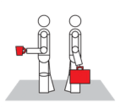Office facts for kids
An office is usually a room or a special area where people do administrative work. This means tasks like organizing, planning, and keeping records. An office can be very small, like a desk in a tiny business. It can also be a huge building filled with many offices. Today, when we talk about an office, we often mean a place where white-collar workers (people who do mental or administrative work) are employed.
Contents
History of Offices as Workplaces
People have been doing administrative work for many centuries. But it's not clear when a room used for paperwork became known as an office. In early Europe, it might have been a room in a palace where someone kept track of the king's money. Before that, records were kept in different ways, not always in a specific room. For example, in ancient China, people used knotted strings to count things as a record. The person keeping records didn't have a special "office" room; they worked wherever they needed to count.
During the early Middle Ages, many monasteries had a scriptorium. This was a place where texts were written and copied by hand. This might be one of the first times a specific room was used like an office. The High Middle Ages (from 1000 to 1300 AD) saw the rise of the medieval chancery. This was usually where most government letters were written and where laws were copied for a kingdom's administration.
Modern Office Spaces
As large, complex organizations grew in the 18th century, the first actual office spaces were built. The Industrial Revolution in the 18th and 19th centuries led to a huge growth in industries like banking, rail, insurance, and telegraphy. Many clerks were needed, which meant more office space was required.
Later, ideas like the "Modern Efficiency Desk" were created. These desks had a flat top and drawers, allowing managers to easily see their workers. However, by the mid-20th century, it became clear that offices needed different levels of privacy. This led to the gradual development of the cubicle system.
The main goal of an office is to help people do their jobs well. Office work spaces are typically used for common activities like reading, writing, and computer tasks. Offices also have meeting rooms, lounges, and areas for support tasks like photocopying and filing. Some even have kitchen areas for workers to prepare food. There are many ways to arrange an office space. These arrangements can depend on the type of work, management styles, and the company's culture.
While offices can be built almost anywhere, modern offices have specific needs. These include good lighting, computer networking, and security. The main purpose of an office building is to provide a place for administrative and managerial workers to do their jobs. These workers usually have specific areas within the building, often with desks, computers, and other equipment they need.
Types of Office Spaces
The main goal of any office is to help people do their jobs effectively and comfortably. Since different people do different tasks, choosing the right office space can be tricky. To help with office design, we can divide office spaces into three main types: work spaces, meeting spaces, and support spaces. For new or growing businesses, serviced offices can offer a simple solution, providing all these types of spaces.
Work Spaces
Work spaces in an office are typically used for common office activities. These include reading, writing, and working on computers. There are nine general types of work spaces, each designed for different activities.
Open office: This is a large work area for more than ten people. It's good for tasks that need lots of communication or routine work that doesn't require deep concentration.
Team space: This is a partially enclosed work area for two to eight people. It's suitable for teamwork that needs frequent talking among the group and a medium level of focus.
Cubicle: This is a partially enclosed work area for one person. It's good for tasks that need medium concentration and a medium amount of interaction with others.
Private office: This is an enclosed work area for one person. It's best for confidential tasks, work that needs a lot of concentration, or many small meetings.
Shared office: This is an enclosed work area for two or three people. It's suitable for work that needs some focus and for working together in small groups.
Team room: This is an enclosed work area for four to ten people. It's good for teamwork that might be confidential and needs frequent communication within the team.
Study booth: This is an enclosed work area for one person. It's suitable for short tasks that need concentration or privacy.
Work lounge: This is a lounge-like work area for two to six people. It's good for short tasks that need teamwork or allow for quick, unplanned conversations.
Touch down: This is an open work area for one person. It's suitable for short tasks that need little concentration and low interaction.
Meeting Spaces
Meeting spaces in an office are typically used for talking and working together. This can be quick chats or intense brainstorming sessions. There are six general types of meeting spaces, each supporting different activities.
Small meeting room: This is an enclosed meeting space for two to four people. It's good for both formal (planned) and informal (casual) discussions.
Large meeting room: This is an enclosed meeting space for five to twelve people. It's suitable for formal meetings.
Small meeting space: This is an open or partially open meeting space for two to four people. It's good for short, informal discussions.
Large meeting space: This is an open or partially open meeting space for five to twelve people. It's good for short, informal discussions.
Brainstorm room: This is an enclosed meeting space for five to twelve people. It's suitable for brainstorming ideas and workshops.
Meeting point: This is an open meeting spot for two to four people. It's good for quick, unplanned meetings.
Support Spaces
Support spaces in an office are typically used for other activities besides main work, like organizing documents or taking a break. There are twelve general types of support spaces, each for different activities.
Filing space: This is an open or enclosed support space for keeping files and documents that are used often.
Storage space: This is an open or enclosed support space for keeping common office supplies.
Print and copy area: This is an open or enclosed support space with machines for printing, scanning, and copying.
Mail area: This is an open or partially open support space where employees can pick up or drop off their personal mail.
Pantry area: This is an open or enclosed support space where people can get coffee, tea, soft drinks, and snacks.
Break area: This is a partially open or enclosed support space where employees can take a break from their work.
Locker area: This is an open or partially open support space where employees can store their personal belongings.
Smoking room: This is an enclosed support space where employees can smoke.
Library: This is a partially open or enclosed support space for reading books, journals, and magazines.
Games room: This is an enclosed support space where employees can play games (like computer games, pool, or darts).
Waiting area: This is an open or partially open support space where visitors can be greeted and wait for their appointment.
Circulation space: This is the support space needed for moving around on office floors, connecting all the main areas.
Images for kids
-
A modern coworking space in London
-
The office of king Carol I of Romania from the Peleș Castle (Sinaia, Romania)
-
K. J. Ståhlberg, the President of Finland, at his office in the Presidential Palace, Helsinki, in 1919
-
An early European office
-
A small office building in Salinas, California, United States
-
Alandia Trade Center, a real estate office building in Mariehamn, Åland
-
Apple Inc. headquarters with neo-futuristic architecture at Apple Park in Cupertino, California, United States.
-
The One World Trade Center in Manhattan is a very tall office building, the tallest of its kind in the U.S.
See also
 In Spanish: Oficina para niños
In Spanish: Oficina para niños


